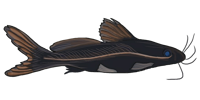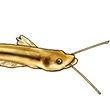Abstract
The viviparous Gyrodactylidae belong to the clade with the highest number of species in
the family (Boeger and Kritsky, 1997; Boeger et al. 2003; Bueno-Silva et al. 2011).
According Boeger et al. (2003), a feature with fundamental importance in diversification
of viviparous Gyrodactylidae is the transmission capacity as adults. This key innovation
is held responsible for the high proportion of adaptive speciation in the group, including
exchange of hosts and geographic dispersion. The study model used in this work
consists of species of Corydoras and their parasites from the upper Iguaçu River. About
4 species of Gyrodactylus are shared by these hosts and the origin of the components
from de Monogenoidea community must involve dispersion and historical process.
Bueno-Silva et al. (2011) suggest, for example, a historical association between G.
corydori and C. ehrhardti with a secondary colonization of the C. paleatus. Results of
this study suggest that use of small mtDNA fragments for species identification can lead
to errors when there are hybrid organisms in population, questioning the efficiency of
DNA barcoding. Also suggests that G. anispharynx and G. superbus are ancestrally
related to C. paleatus with structures populations in both hosts, while G. corydori has a
historical association with C. ehrhardti and don't present structured populations. The
current distribution of hosts and parasites system indicates that the parasites have
characteristics that allow the use indiscriminate or not, of resources (hosts) similar. It
was expected that there would be a reduction in the effective population size that could
indicate host switch, however in this study was not found population growth in any of the
three species analyzed, but a decline for about 13,000 years associated with Quaternary
climatic events. Finally, the results obtained can propose a scenario where sympatric
speciation was of fundamental importance to diversity the lineage today consist of G.
anisopharynx and G. corydori when this ancestral lineage found availability of new
resource after C. paleatus colonization in the Iguaçu river basin.
Key word: Monogenoidea, Gyrodactylidae, Coevolution, Historical Association.




